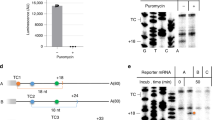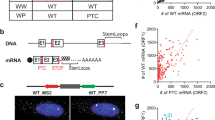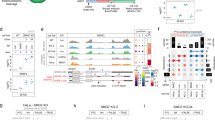Abstract
Nonsense-mediated mRNA decay (NMD) is a translation-coupled mechanism that eliminates mRNAs containing premature translation-termination codons (PTCs). In mammalian cells, NMD is also linked to pre-mRNA splicing, as in many instances strong mRNA reduction occurs only when the PTC is located upstream of an intron. It is proposed that in these systems, the exon junction complex (EJC) mediates the link between splicing and NMD. Recent studies have questioned the role of splicing and the EJC in initiating NMD. Instead, they put forward a general and evolutionarily conserved mechanism in which the main regulator of NMD is the distance between a PTC and the poly(A) tail of an mRNA. Here we discuss the limitations of the new NMD model and the EJC concept; we argue that neither satisfactorily accounts for all of the available data and offer a new model to test in future studies.
This is a preview of subscription content, access via your institution
Access options
Subscribe to this journal
Receive 12 print issues and online access
$189.00 per year
only $15.75 per issue
Buy this article
- Purchase on Springer Link
- Instant access to full article PDF
Prices may be subject to local taxes which are calculated during checkout


Similar content being viewed by others
References
Maquat, L.E. When cells stop making sense: effects of nonsense codons on RNA metabolism in vertebrate cells. RNA 1, 453–465 (1995).
Peltz, S.W., Brown, A.H. & Jacobson, A. Messenger RNA destabilization triggered by premature translational termination depends on at least 3 cis-acting sequence elements and one trans-acting factor. Genes Dev. 7, 1737–1754 (1993).
Morse, D.E. & Yanofsky, C. Polarity and the degradation of mRNA. Nature 224, 329–331 (1969).
Amrani, N., Sachs, M.S. & Jacobson, A. Early nonsense: mRNA decay solves a translational problem. Nat. Rev. Mol. Cell Biol. 7, 415–425 (2006).
Maquat, L.E. Nonsense-mediated mRNA decay: splicing, translation and mRNP dynamics. Nat. Rev. Mol. Cell Biol. 5, 89–99 (2004).
Culbertson, M.R., Underbrink, K.M. & Fink, G.R. Frameshift suppression in Saccharomyces cerevisiae II. Genetic properties of group II suppressors. Genetics 95, 833–853 (1980).
Conti, E. & Izaurralde, E. Nonsense-mediated mRNA decay: molecular insights and mechanistic variations across species. Curr. Opin. Cell Biol. 17, 316–325 (2005).
Cui, Y., Gonzalez, C.I., Kinzy, T.G., Dinman, J.D. & Peltz, S.W. Mutations in the MOF2/SUI1 gene affect both translation and nonsense-mediated mRNA decay. RNA 5, 794–804 (1999).
Welch, E.M. & Jacobson, A. An internal open reading frame triggers nonsense-mediated decay of the yeast SPT10 mRNA. EMBO J. 18, 6134–6145 (1999).
Cali, B.M., Kuchma, S.L., Latham, J. & Anderson, P. smg-7 is required for mRNA surveillance in Caenorhabditis elegans. Genetics 151, 605–616 (1999).
Hodgkin, J., Papp, A., Pulak, R., Ambros, V. & Anderson, P. A new kind of informational suppression in the nematode Caenorhabditis elegans. Genetics 123, 301–313 (1989).
Page, M.F., Carr, B., Anders, K.R., Grimson, A. & Anderson, P. SMG-2 is a phosphorylated protein required for mRNA surveillance in Caenorhabditis elegans and related to Upf1p of yeast. Mol. Cell. Biol. 19, 5943–5951 (1999).
Grimson, A., O'Connor, S., Newman, C.L. & Anderson, P. SMG-1 is a phosphatidylinositol kinase-related protein kinase required for nonsense-mediated mRNA decay in Caenorhabditis elegans. Mol. Cell. Biol. 24, 7483–7490 (2004).
Unterholzner, L. & Izaurralde, E. SMG7 acts as a molecular link between mRNA surveillance and mRNA decay. Mol. Cell 16, 587–596 (2004).
Kashima, I. et al. Binding of a novel SMG-1-Upf1-eRF1-eRF3 complex (SURF) to the exon junction complex triggers Upf1 phosphorylation and nonsense-mediated mRNA decay. Genes Dev. 20, 355–367 (2006).
He, F., Peltz, S.W., Donahue, J.L., Rosbash, M. & Jacobson, A. Stabilization and ribosome association of unspliced pre-mRNAs in a yeast Upf1– mutant. Proc. Natl. Acad. Sci. USA 90, 7034–7038 (1993).
Sayani, S., Janis, M., Lee, C.Y., Toesca, I. & Chanfreau, G.F. Widespread impact of nonsense-mediated mRNA decay on the yeast intronome. Mol. Cell 31, 360–370 (2008).
Jaillon, O. et al. Translational control of intron splicing in eukaryotes. Nature 451, 359–362 (2008).
McGlincy, N.J. & Smith, C.W. Alternative splicing resulting in nonsense-mediated mRNA decay: what is the meaning of nonsense? Trends Biochem. Sci. 33, 385–393 (2008).
Rehwinkel, J., Raes, J. & Izaurralde, E. Nonsense-mediated mRNA decay: target genes and functional diversification of effectors. Trends Biochem. Sci. 31, 639–646 (2006).
Medghalchi, S.M. et al. Rent1, a trans-effector of nonsense-mediated mRNA decay, is essential for mammalian embryonic viability. Hum. Mol. Genet. 10, 99–105 (2001).
Metzstein, M.M. & Krasnow, M.A. Functions of the nonsense-mediated mRNA decay pathway in Drosophila development. PLoS Genet. 2, e180 (2006).
Yoine, M., Nishii, T. & Nakamura, K. Arabidopsis UPF1 RNA helicase for nonsense-mediated mRNA decay is involved in seed size control and is essential for growth. Plant Cell Physiol. 47, 572–580 (2006).
Weischenfeldt, J. et al. NMD is essential for hematopoietic stem and progenitor cells and for eliminating by-products of programmed DNA rearrangements. Genes Dev. 22, 1381–1396 (2008).
Ajamian, L. et al. Unexpected roles for UPF1 in HIV-1 RNA metabolism and translation. RNA 14, 914–927 (2008).
Azzalin, C.M. & Lingner, J. The human RNA surveillance factor UPF1 is required for S phase progression and genome stability. Curr. Biol. 16, 433–439 (2006).
Luke, B. et al. Saccharomyces cerevisiae Ebs1p is a putative ortholog of human Smg7 and promotes nonsense-mediated mRNA decay. Nucleic Acids Res. 35, 7688–7697 (2007).
Azzalin, C.M., Reichenbach, P., Khoriauli, L., Giulotto, E. & Lingner, J. Telomeric repeat containing RNA and RNA surveillance factors at mammalian chromosome ends. Science 318, 798–801 (2007).
Brumbaugh, K.M. et al. The mRNA surveillance protein hSMG-1 functions in genotoxic stress response pathways in mammalian cells. Mol. Cell 14, 585–598 (2004).
Zhang, S, Ruizechevarria, M.J., Quan, Y. & Peltz, S.W. Identification and characterization of a sequence motif involved in nonsense-mediated messenger RNA decay. Mol. Cell. Biol. 15, 2231–2244 (1995).
Gonzalez, C.I., Ruiz-Echevarria, M.J., Vasudevan, S., Henry, M.F. & Peltz, S.W. The yeast hnRNP-like protein Hrp1/Nab4 marks a transcript for nonsense-mediated mRNA decay. Mol. Cell 5, 489–499 (2000).
Hilleren, P. & Parker, R. mRNA surveillance in eukaryotes: kinetic proofreading of proper translation termination as assessed by mRNP domain organization? RNA 5, 711–719 (1999).
Muhlrad, D. & Parker, R. Aberrant mRNAs with extended 3′ UTRs are substrates for rapid degradation by mRNA surveillance. RNA 5, 1299–1307 (1999).
Amrani, N. et al. A faux 3′-UTR promotes aberrant termination and triggers nonsense-mediated mRNA decay. Nature 432, 112–118 (2004).
Hoshino, S., Imai, M., Kobayashi, T., Uchida, N. & Katada, T. The eukaryotic polypeptide chain releasing factor (eRF3/GSPT) carrying the translation termination signal to the 3′-poly(A) tail of mRNA. Direct association of erf3/GSPT with polyadenylate-binding protein. J. Biol. Chem. 274, 16677–16680 (1999).
Cosson, B. et al. Poly(A)-binding protein acts in translation termination via eukaryotic release factor 3 interaction and does not influence [PSI(+)] propagation. Mol. Cell. Biol. 22, 3301–3315 (2002).
Zhang, J., Sun, X.L., Qian, Y.M., LaDuca, J.P. & Maquat, L.E. At least one intron is required for the nonsense-mediated decay of triosephosphate isomerase mRNA: a possible link between nuclear splicing and cytoplasmic translation. Mol. Cell. Biol. 18, 5272–5283 (1998).
Carter, M.S., Li, S.L. & Wilkinson, M.F. A splicing dependent regulatory mechanism that detects translation signals. EMBO J. 15, 5965–5975 (1996).
Thermann, R. et al. Binary specification of nonsense codons by splicing and cytoplasmic translation. EMBO J. 17, 3484–3494 (1998).
Brocke, K.S., Neu-Yilik, G., Gehring, N.H., Hentze, M.W. & Kulozik, A.E. The human intronless melanocortin 4-receptor gene is NMD insensitive. Hum. Mol. Genet. 11, 331–335 (2002).
Maquat, L.E. & Li, X. Mammalian heat shock p70 and histone H4 transcripts, which derive from naturally intronless genes, are immune to nonsense-mediated decay. RNA 7, 445–456 (2001).
Nagy, E. & Maquat, L.E. A rule for termination-codon position within intron-containing genes: when nonsense affects RNA abundance. Trends Biochem. Sci. 23, 198–199 (1998).
Le Hir, H., Gatfield, D., Izaurralde, E. & Moore, M.J. The exon-exon junction complex provides a binding platform for factors involved in mRNA export and nonsense-mediated mRNA decay. EMBO J. 20, 4987–4997 (2001).
Chamieh, H., Ballut, L., Bonneau, F. & Le Hir, H. NMD factors UPF2 and UPF3 bridge UPF1 to the exon junction complex and stimulate its RNA helicase activity. Nat. Struct. Mol. Biol. 15, 85–93 (2008).
Ishigaki, Y., Li, X., Serin, G. & Maquat, L.E. Evidence for a pioneer round of mRNA translation: mRNAs subject to nonsense-mediated decay in mammalian cells are bound by CBP80 and CBP20. Cell 106, 607–617 (2001).
Lejeune, F., Ishigaki, Y., Li, X. & Maquat, L.E. The exon junction complex is detected on CBP80-bound but not eIF4E-bound mRNA in mammalian cells: dynamics of mRNP remodeling. EMBO J. 21, 3536–3545 (2002).
Tange, T.O., Nott, A. & Moore, M.J. The ever-increasing complexities of the exon junction complex. Curr. Opin. Cell Biol. 16, 279–284 (2004).
Serin, G., Gersappe, A., Black, J.D., Aronoff, R. & Maquat, L.E. Identification and characterization of human orthologues to Saccharomyces cerevisiae Upf2 protein and Upf3 protein (Caenorhabditis elegans SMG-4). Mol. Cell. Biol. 21, 209–223 (2001).
Ivanov, P.V., Gehring, N.H., Kunz, J.B., Hentze, M.W. & Kulozik, A.E. Interactions between UPF1, eRFs, PABP and the exon junction complex suggest an integrated model for mammalian NMD pathways. EMBO J. 27, 736–747 (2008).
Buhler, M., Paillusson, A. & Muhlemann, O. Efficient downregulation of immunoglobulin μ mRNA with premature translation-termination codons requires the 5′-half of the VDJ exon. Nucleic Acids Res. 32, 3304–3315 (2004).
Wang, J., Gudikote, J.P., Olivas, O.R. & Wilkinson, M.F. Boundary-independent polar nonsense-mediated decay. EMBO Rep. 3, 274–279 (2002).
Gatfield, D., Unterholzner, L., Ciccarelli, F.D., Bork, P. & Izaurralde, E. Nonsense-mediated mRNA decay in Drosophila: at the intersection of the yeast and mammalian pathways. EMBO J. 22, 3960–3970 (2003).
Longman, D., Plasterk, R.H., Johnstone, I.L. & Caceres, J.F. Mechanistic insights and identification of two novel factors in the C. elegans NMD pathway. Genes Dev. 21, 1075–1085 (2007).
Behm-Ansmant, I., Gatfield, D., Rehwinkel, J., Hilgers, V. & Izaurralde, E. A conserved role for cytoplasmic poly(A)-binding protein 1 (PABPC1) in nonsense-mediated mRNA decay. EMBO J. 26, 1591–1601 (2007).
Silva, A.L., Ribeiro, P., Inacio, A., Liebhaber, S.A. & Romao, L. Proximity of the poly(A)-binding protein to a premature termination codon inhibits mammalian nonsense-mediated mRNA decay. RNA 14, 563–576 (2008).
Buhler, M., Steiner, S., Mohn, F., Paillusson, A. & Muhlemann, O. EJC-independent degradation of nonsense immunoglobulin-μ mRNA depends on 3′ UTR length. Nat. Struct. Mol. Biol. 13, 462–464 (2006).
Singh, G., Rebbapragada, I. & Lykke-Andersen, J. A competition between stimulators and antagonists of Upf complex recruitment governs human nonsense-mediated mRNA decay. PLoS Biol. 6, e111 (2008).
Eberle, A.B., Stalder, L., Mathys, H., Orozco, R.Z. & Muhlemann, O. Posttranscriptional gene regulation by spatial rearrangement of the 3′ untranslated region. PLoS Biol. 6, e92 (2008).
Mangus, D.A., Evans, M.C. & Jacobson, A. Poly(A)-binding proteins: multifunctional scaffolds for the post-transcriptional control of gene expression. Genome Biol. 4, 223 (2003).
Losson, R. & Lacroute, F. Interference of nonsense mutations with eukaryotic messanger RNA stability. Proc. Natl. Acad. Sci. USA 76, 5134–5137 (1979).
Brogna, S. Nonsense mutations in the alcohol dehydrogenase gene of Drosophila melanogaster correlate with an abnormal 3′ end processing of the corresponding pre-mRNA. RNA 5, 562–573 (1999).
Yun, D.F. & Sherman, F. Initiation of translation can occur only in a restricted region of the CYC1 mRNA of Saccharomyces cerevisiae. Mol. Cell. Biol. 15, 1021–1033 (1995).
Sachs, A. Physical and functional interactions between the mRNA cap structure and the poly(A) tail. in Translational Control of Gene Expression. (eds. Sonenberg, N., Hershey, J.W.B. & Mathews, M.B.) 447–465 (Cold Spring Harbor Laboratory Press, Cold Spring Harbor, New York, 2000).
Amrani, N., Ghosh, S., Mangus, D.A. & Jacobson, A. Translation factors promote the formation of two states of the closed-loop mRNP. Nature 453, 1276–1280 (2008).
Imataka, H., Gradi, A. & Sonenberg, N. A newly identified N-terminal amino acid sequence of human eIF4G binds poly(A)-binding protein and functions in poly(A)-dependent translation. EMBO J. 17, 7480–7489 (1998).
Le, H. et al. Translation initiation factors eIF-iso4G and eIF-4B interact with the poly(A)-binding protein and increase its RNA binding activity. J. Biol. Chem. 272, 16247–16255 (1997).
Christensen, A.K. & Bourne, C.M. Shape of large bound polysomes in cultured fibroblasts and thyroid epithelial cells. Anat. Rec. 255, 116–129 (1999).
Kuperwasser, N., Brogna, S., Dower, K. & Rosbash, M. Nonsense-mediated decay does not occur within the yeast nucleus. RNA 10, 1907–1915 (2004).
Romao, L. et al. Nonsense mutations in the human β-globin gene lead to unexpected levels of cytoplasmic mRNA accumulation. Blood 96, 2895–2901 (2000).
Belgrader, P., Cheng, J., Zhou, X.B., Stephenson, L.S. & Maquat, L.E. Mammalian nonsense codons can be cis effectors of nuclear messenger RNA half life. Mol. Cell. Biol. 14, 8219–8228 (1994).
Zhang, J. & Maquat, L.E. Evidence that translation reinitiation abrogates nonsense-mediated mRNA decay in mammalian cells. EMBO J. 16, 826–833 (1997).
Inacio, A. et al. Nonsense mutations in close proximity to the initiation codon fail to trigger full nonsense-mediated mRNA decay. J. Biol. Chem. 279, 32170–32180 (2004).
Poyry, T.A., Kaminski, A. & Jackson, R.J. What determines whether mammalian ribosomes resume scanning after translation of a short upstream open reading frame? Genes Dev. 18, 62–75 (2004).
Szamecz, B. et al. eIF3a cooperates with sequences 5′ of uORF1 to promote resumption of scanning by post-termination ribosomes for reinitiation on GCN4 mRNA. Genes Dev. 22, 2414–2425 (2008).
Kahvejian, A., Svitkin, Y.V., Sukarieh, R., M'Boutchou, M.N. & Sonenberg, N. Mammalian poly(A)-binding protein is a eukaryotic translation initiation factor, which acts via multiple mechanisms. Genes Dev. 19, 104–113 (2005).
Gilbert, W.V., Zhou, K., Butler, T.K. & Doudna, J.A. Cap-independent translation is required for starvation-induced differentiation in yeast. Science 317, 1224–1227 (2007).
Coller, J.M., Gray, N.K. & Wickens, M.P. mRNA stabilization by poly(A) binding protein is independent of poly(A) and requires translation. Genes Dev. 12, 3226–3235 (1998).
Meaux, S., van Hoof, A. & Baker, K.E. Nonsense-mediated mRNA decay in yeast does not require PAB1 or a poly(A) tail. Mol. Cell 29, 134–140 (2008).
Simon, E. & Seraphin, B. A specific role for the C-terminal region of the poly(A)-binding protein in mRNA decay. Nucleic Acids Res. 35, 6017–6028 (2007).
Neu-Yilik, G. et al. Splicing and 3′ end formation in the definition of nonsense-mediated decay-competent human β-globin mRNPs. EMBO J. 20, 532–540 (2001).
Ling, J., Morley, S.J., Pain, V.M., Marzluff, W.F. & Gallie, D.R. The histone 3′-terminal stem-loop-binding protein enhances translation through a functional and physical interaction with eukaryotic initiation factor 4G (eIF4G) and eIF3. Mol. Cell. Biol. 22, 7853–7867 (2002).
Kaygun, H. & Marzluff, W.F. Regulated degradation of replication-dependent histone mRNAs requires both ATR and Upf1. Nat. Struct. Mol. Biol. 12, 794–800 (2005).
Isken, O. et al. Upf1 phosphorylation triggers translational repression during nonsense-mediated mRNA decay. Cell 133, 314–327 (2008).
Morris, C., Wittmann, J., Jack, H.M. & Jalinot, P. Human INT6/eIF3e is required for nonsense-mediated mRNA decay. EMBO Rep. 8, 596–602 (2007).
Pisarev, A.V., Hellen, C.U. & Pestova, T.V. Recycling of eukaryotic posttermination ribosomal complexes. Cell 131, 286–299 (2007).
Lejeune, F., Li, X. & Maquat, L.E. Nonsense-mediated mRNA decay in mammalian cells involves decapping, deadenylating, and exonucleolytic activities. Mol. Cell 12, 675–687 (2003).
Gatfield, D. & Izaurralde, E. Nonsense-mediated messenger RNA decay is initiated by endonucleolytic cleavage in Drosophila. Nature 429, 575–578 (2004).
Huntzinger, E., Kashima, I., Fauser, M., Sauliere, J. & Izaurralde, E. SMG6 is the catalytic endonuclease that cleaves mRNAs containing nonsense codons in metazoan. RNA 14, 2609–2617 (2008).
Eberle, A.B., Lykke-Andersen, S., Muhlemann, O. & Jensen, T.H. SMG6 promotes endonucleolytic cleavage of nonsense mRNA in human cells. Nat. Struct. Mol. Biol. 16, 49–55 (2009).
Johansson, M.J., He, F., Spatrick, P., Li, C. & Jacobson, A. Association of yeast Upf1p with direct substrates of the NMD pathway. Proc. Natl. Acad. Sci. USA 104, 20872–20877 (2007).
Kopeina, G.S. et al. Step-wise formation of eukaryotic double-row polyribosomes and circular translation of polysomal mRNA. Nucleic Acids Res. 36, 2476–2488 (2008).
Uchida, N., Hoshino, S., Imataka, H., Sonenberg, N. & Katada, T. A novel role of the mammalian GSPT/eRF3 associating with poly(A)-binding protein in cap/poly(A)-dependent translation. J. Biol. Chem. 277, 50286–50292 (2002).
Matsuda, D., Hosoda, N., Kim, Y.K. & Maquat, L.E. Failsafe nonsense-mediated mRNA decay does not detectably target eIF4E-bound mRNA. Nat. Struct. Mol. Biol. 14, 974–979 (2007).
Nott, A., Meislin, S.H. & Moore, M.J. A quantitative analysis of intron effects on mammalian gene expression. RNA 9, 607–617 (2003).
Ma, X.M., Yoon, S.O., Richardson, C.J., Julich, K. & Blenis, J. SKAR links pre-mRNA splicing to mTOR/S6K1-mediated enhanced translation efficiency of spliced mRNAs. Cell 133, 303–313 (2008).
Brogna, S., Sato, T.A. & Rosbash, M. Ribosome components are associated with sites of transcription. Mol. Cell 10, 93–104 (2002).
Iborra, F.J., Jackson, D.A. & Cook, P.R. Coupled transcription and translation within nuclei of mammalian cells. Science 293, 1139–1142 (2001).
Maquat, L.E. NASty effects on fibrillin pre-mRNA splicing: another case of ESE does it, but proposals for translation-dependent splice site choice live on. Genes Dev. 16, 1743–1753 (2002).
Gehring, N.H. et al. Exon-junction complex components specify distinct routes of nonsense-mediated mRNA decay with differential cofactor requirements. Mol. Cell 20, 65–75 (2005).
Chan, W.K. et al. An alternative branch of the nonsense-mediated decay pathway. EMBO J. 26, 1820–1830 (2007).
Acknowledgements
We thank B. Michell for critically reading the manuscript. S.B. is supported by a Royal Society URF fellowship and J.W. by a Darwin Trust PhD Scholarship.
Author information
Authors and Affiliations
Rights and permissions
About this article
Cite this article
Brogna, S., Wen, J. Nonsense-mediated mRNA decay (NMD) mechanisms. Nat Struct Mol Biol 16, 107–113 (2009). https://doi.org/10.1038/nsmb.1550
Issue Date:
DOI: https://doi.org/10.1038/nsmb.1550
This article is cited by
-
Stress decreases spermatozoa quality and induces molecular alterations in zebrafish progeny
BMC Biology (2023)
-
SARS-CoV-2 helicase might interfere with cellular nonsense-mediated RNA decay: insights from a bioinformatics study
BMC Genomic Data (2023)
-
Functional consequences of C-terminal mutations in RUNX2
Scientific Reports (2023)
-
New CRISPR Technology for Creating Cell Models of Lipoprotein Assembly and Secretion
Current Atherosclerosis Reports (2023)
-
Stat3 Has a Different Role in Axon Growth During Development Than It Does in Axon Regeneration After Injury
Molecular Neurobiology (2023)



